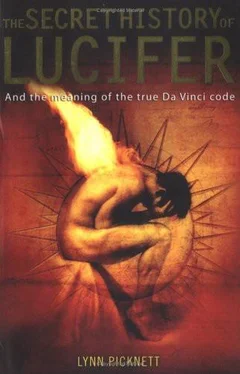Despite Madeleine's confession, Gaufridi was `persuaded' to reveal the formula of his Devil's pact, which read:
I, Louis Gaufridi, renounce all good, both spiritual as well as temporal, which may be bestowed upon me by God, the Blessed Virgin Mary, all the Saints of Heaven, particularly my patron S. John-Baptist, as also S. Peter, S. Paul, and S. Francis, and I give myself body and soul to Lucifer, before whom I stand, together with every good that I may ever possess (save always the benefit of the sacraments touching those who receive them). And according to the tenor of these terms have I signed and sealed 22
Gaufridi's alleged victim, Madeleine, signed an even more blood-curdlingly blasphemous pact:
With all my heart and most unfeignedly and with all my will most deliberately do I wholly renounce God, Father, Son, and Holy Ghost; the most Holy Mother of God; all the Angels and especially my Guardian Angel, the passion of Our Lord Jesus Christ, His Precious Blood and the merits thereof, my lot in Paradise, all the good inspirations which God may give me in the future, all prayers which are made or may be made for me.23
If nothing else, these pacts reveal a real talent on the part of the local officers of the Inquisition for imaginative Devil worship. They also underline the central point that without the Church there could be no Devil worship and even no Devil. The one feeds off the other.
Gaufridi and Grandier were almost certainly innocent of the Satanism of which they were accused and for which they died so horribly, although they may have encouraged the women of the convent to flirt - perhaps a little more than that. However, others, like Faust, were not necessarily so blameless, although the extent to which one apportions sin will depend on one's own spiritual background.
Trampling the cross
Jeffrey Burton Russell explains that the earliest idea of the pact - originally a deal between two more or less equal parties - changed dramatically in medieval times:
It was now assumed that the person making the pact did so as a grovelling slave, renouncing Christ, trampling the cross, worshipping Satan ... offering the obscene kiss ... Heretics and other evildoers had put themselves under Lucifer's command whether or not they had made a conscious and deliberate submission.21
Certain elements in that list echo the alleged blasphemies of the Knights Templar - specifically trampling the cross and renouncing Christ. Almost all historians reject the reality of these accusations, and one can understand why, given the prevalence of confessionby-torture: basically this is inadmissible evidence. But in this case, is it really worthless? As we have seen, the fact of the existence of the `Church of John in the East', the Mandaeans, who encountered the knights in what is now Turkey, adds an ironic twist to the tale. If the inner circle, or at any rate a high-ranking group, within the Templars did indeed become enthused with (most would say, with Summers, `infected by') the Johannite heresy, then no doubt they really did spit and trample on the cross and renounce Jesus, seeing him as an impostor, usurper and possibly even accomplice or accessory to the fact of murder. But to many of the initiates, steeped as they were in that time with a fervent belief in the conventions of Christianity - after all, most Templars joined the Order because they were devoted to Christ - such actions must still have seemed blasphemous, even diabolic. Perhaps in their heart of hearts they truly believed themselves to have gone over to the other side, to be Devil worshippers. This echoes the Cathars' concept of the Baptist as a devil: this would make sense if they knew that the two men had been bitter rivals, for assuming (and who wouldn't?) that Christ is without question always and for ever Goodness personified - the cowboy in the white hat as it were, intent on cleaning up the town - John must therefore be Evil, the scowling bar-brawler in the black hat. But as the song says, `It ain't necessarily so'.
While the Templars' contribution to humanity may not be great - although they did give us the monetary cheque and some stunning Gothic cathedrals - other heretics and Luciferans gave us much more that has proved of lasting value. Indeed, it is true to say that without their intellectual striving, we may well still be in the Dark Ages. Although the true flowering of both these official and unknowing Luciferans was to come much later, in the Age of Enlightenment, its roots were already thrusting through the tentatively promising soil of the Renaissance, nourished in the dark on Mephistophelean magic.
Anti-Christ
When Leonardo da Vinci mused on the painter's power exalting him to the status of the `Grandson of God',25 it was both a curious and extraordinarily bold statement, for its implications are nothing if not outrageously heretical. To most people, both then and now, it was and is an unwritten article of faith that Jesus was a lifelong, pure celibate, with no children - so to talk of God possessing a grandson, however metaphorically, is astonishing blasphemy. It may be countered that it was merely a clever turn of phrase, virtually meaningless, implying a vague grandeur, nothing more - and that it is pointless trying to analyse it. After all, writers have routinely called themselves the likes of `children of Nature': in his 1914 Immanuel Kant Houston Stewart Chamberlain declared that `All arts, all sciences, all Thought are "daughters of the Eye"', adding `and so it is that the painter is "nipote a Dio", "the grandson of God"'. But he completely misses the point. Being a child of Nature is one thing, but even daring to imply, however poetically or metaphorically that Jesus had children was nothing short of extreme heresy. But in any case, this is Leonardo da Vinci, a viciously antiChurch heretic: indeed, as a sort of Anti-Christ himself, when he made any remark about the Deity it is surely worth noting.
So what drove Leonardo to make such a dangerously controversial statement, even in the privacy of his own notebooks? What did he really mean by aligning himself with the `Grandson of God'? Was he claiming kinship with the historical figure of Christ? (Although, judging by his anti-Jesus, wickedly Johannite symbolism, that seems rather unlikely.) Was he perhaps even implying that he knew Jesus had a son? Or was he not referring, however indirectly, to Jesus at all - but to John? Clearly he saw the Baptist, as least figuratively, as Son of God, and few Johannites would qualify more in their devotion to the cause to be his `son' than Leonardo da Vinci. Whatever his motive, likening himself to the grandson of God would not have been the chosen metaphor of a God-fearing, devout Renaissance Catholic - quite the reverse.
In any case, few more Luciferan individuals than Leonardo da Vinci have ever walked the earth, in his audacity, his refusal to set limits on his own potential or imagination, and his constant challenge to received wisdom, especially to the religious establishment of his day.
In Turin Shroud: In Whose Image?26 Clive Prince and I argued that the `Holy Shroud of Turin' - long believed to bear the miraculously imprinted image of Jesus himself, complete with horrific marks of crucifixion - was a brilliant fake by Leonardo, who not only used his own face for that of Jesus', but created the image using a technique that we now know as photography. In fact, we argue, the Shroud is nothing less than a 500-year-old photograph of Leonardo da Vinci ...
And, with supreme Luciferan genius (although many would call it somewhat warped), he used this pioneering and `devilish' technique to create the ultimate Christian relic, thus ensuring that the priests of the organization he abhorred kept it safe for posterity. That particular example of Luciferan guile - the ultimate practical joke aimed at undermining the very Church that kept the Shroud alive for believers for centuries - shows real inspiration. How he must have laughed. And the Da Vinci `Holy Shroud' contains its very own code.
Читать дальше












